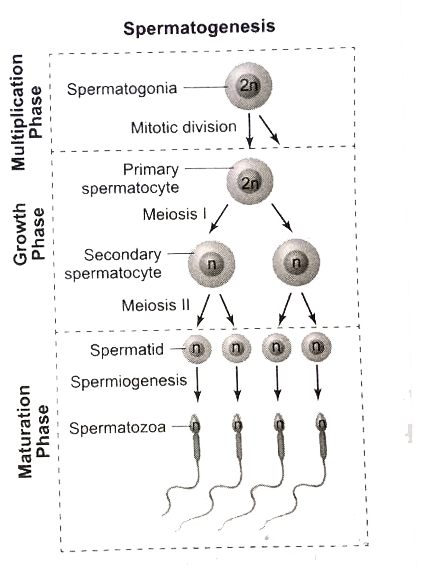Explain the process of spermatogenesis with diagram. Solution in Tamil
Spermatogenesis is the sequence of events Spermatogenesis in the seminiferous tubules of the testes that produce the male gametes, the sperms. During development, the primordial germ cells migrate into the testes and become immature germ cells called sperm mother cells or spermatogonia in the inner surfaces of spermatocyte the seminiferous tubules. The spermatogonia begin to undergo mitotic division at puberty and continue throughout life. In the first stage of spermatogenesis, the spermatogonia migrate among sertoli cells towards the central lumen of the seminiferous tubule and become modified and enlarged to form primary spermatocytes which are diploid with 23 pairs i.e., 46 chromosomes. Some of the primary spermatocytes undergo first meiotic division to form two secondary spermatocytes which are haploid with 23 chromosomes each. The secondary spermatocytes undergo second meiotic division to produce four haploid spermatids. The spermatids are transformed into mature permatozoa (sperms) by the process called spermiogenesis. Sperms are finally released into the cavity of seminiferous tubules by a process called spermiation.

The whole process of spermatogenesis takes about 64 days. At any given time, different regions of the seminiferous tubules contain spermatocytes in different stages of development. The sperm production remains nearly constant at a rate of about 200 million sperms per day. Spermatogenesis starts at the age of puberty and is initiated due to the increase in the release of Gonadotropin Releasing Hormone (GnRH) by the hypothalamus. GnRH acts on the anterior pituitary gland and stimulates the secretion of two gonadotropins namely Follicle Stimulating Hormone (FSH) and Lutenizing Hormone (LH). FSH stimulates testicular growth and enhances the production of Androgen Binding Protein (ABP) by the sertoli cells and helps in the process of spermiogenesis. LH acts on the Leydig cells and stimulates the synthesis of testosterone which in turn stimulates the process of spermatogenesis.
Topper's Solved these Questions
- HUMAN REPRODUCTIONBOOK - FULL MARKSCHAPTER - HUMAN REPRODUCTIONEXERCISE - Higher Order Thinking Skills (HOTs) Questions
4 Videos
- HUMAN REPRODUCTIONBOOK - FULL MARKSCHAPTER - HUMAN REPRODUCTIONEXERCISE - Additional questions (3-marks questions)
22 Videos
- Human health and diseasesBOOK - FULL MARKSCHAPTER - Human health and diseasesEXERCISE - Additional questions - Higher order thinking skills(HOTs)Questions
3 Videos
- MICROBES IN HUMAN WELFARE BOOK - FULL MARKSCHAPTER - MICROBES IN HUMAN WELFARE EXERCISE - Higher Order Thinking Skill (HOTs) Questions
4 Videos
Similar Questions
Give the alternate terminologies for (a) Spermatogonia (b) Embryonic ectoderm
View SolutionWhat is organogenesis?
View SolutionIdentify the mismatched pair and give reason.
(a)Plague-Yersinia pestis
(b)Filariasis-Wuchereria bancrofti
(C )Dermatomycosis-Trypanosoma gambiense
(d)Common cold -Rhino virus
View SolutionOne can notice large holes in Swiss cheese . Which bacterium is responible for these holes . What are these holes due to ?
View Solution(a) Explain the process of spermatogenesis in humans.
View SolutionDescribe the T.S. of human testic and explain the process of spermatogenesis.
View SolutionDescribe the T.S. of testis and explain the process of spermatogenesis.
View Solutionशुक्राणुजनन की क्रिया को केवल चित्र द्वारा समझाइए।
View SolutionWhat is spermatogenesis? Briefly describe the process of spermatogenesis.
View SolutionWhat is spermatogenesis? Explain the process of spermatogenesis.
View SolutionWhat is Spermatogenesis ? Explain the process of spermatogenesisi.
View SolutionExplain the process of spermatogenesis with diagram.
View SolutionWhat is spermatogenesis? Briefly describe the process of spermatogenesis.
View SolutionWhat is spermatogenesis? With the help of a suitable diagram describe different steps involved in this process.
View SolutionDefine spermatogenesis. Explain the process of spermatogenesis.
View SolutionWhat is spermatogenesis? Briefly describe the process of spermatogenesis.
View Solution
